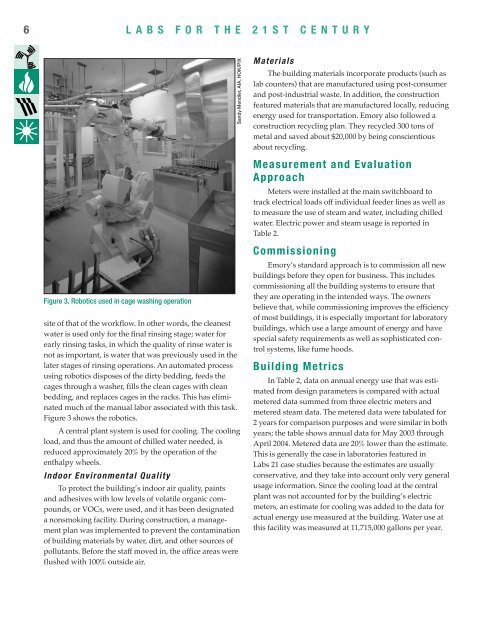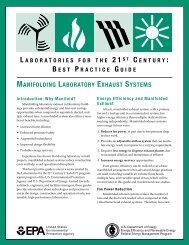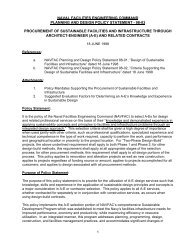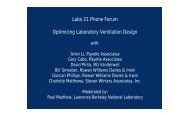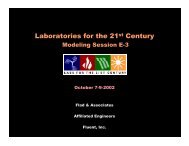Whitehead Biomedical Research Building at Emory University ... - I2SL
Whitehead Biomedical Research Building at Emory University ... - I2SL
Whitehead Biomedical Research Building at Emory University ... - I2SL
Create successful ePaper yourself
Turn your PDF publications into a flip-book with our unique Google optimized e-Paper software.
6L A B S F O R T H E 2 1 S T C E N T U R YFigure 3. Robotics used in cage washing oper<strong>at</strong>ionsite of th<strong>at</strong> of the workflow. In other words, the cleanestw<strong>at</strong>er is used only for the final rinsing stage; w<strong>at</strong>er forearly rinsing tasks, in which the quality of rinse w<strong>at</strong>er isnot as important, is w<strong>at</strong>er th<strong>at</strong> was previously used in thel<strong>at</strong>er stages of rinsing oper<strong>at</strong>ions. An autom<strong>at</strong>ed processusing robotics disposes of the dirty bedding, feeds thecages through a washer, fills the clean cages with cleanbedding, and replaces cages in the racks. This has elimin<strong>at</strong>edmuch of the manual labor associ<strong>at</strong>ed with this task.Figure 3 shows the robotics.A central plant system is used for cooling. The coolingload, and thus the amount of chilled w<strong>at</strong>er needed, isreduced approxim<strong>at</strong>ely 20% by the oper<strong>at</strong>ion of theenthalpy wheels.Indoor Environmental QualityTo protect the building’s indoor air quality, paintsand adhesives with low levels of vol<strong>at</strong>ile organic compounds,or VOCs, were used, and it has been design<strong>at</strong>eda nonsmoking facility. During construction, a managementplan was implemented to prevent the contamin<strong>at</strong>ionof building m<strong>at</strong>erials by w<strong>at</strong>er, dirt, and other sources ofpollutants. Before the staff moved in, the office areas wereflushed with 100% outside air.Sandy Mendler, AIA, HOK/PIXM<strong>at</strong>erialsThe building m<strong>at</strong>erials incorpor<strong>at</strong>e products (such aslab counters) th<strong>at</strong> are manufactured using post-consumerand post-industrial waste. In addition, the constructionfe<strong>at</strong>ured m<strong>at</strong>erials th<strong>at</strong> are manufactured locally, reducingenergy used for transport<strong>at</strong>ion. <strong>Emory</strong> also followed aconstruction recycling plan. They recycled 300 tons ofmetal and saved about $20,000 by being conscientiousabout recycling.Measurement and Evalu<strong>at</strong>ionApproachMeters were installed <strong>at</strong> the main switchboard totrack electrical loads off individual feeder lines as well asto measure the use of steam and w<strong>at</strong>er, including chilledw<strong>at</strong>er. Electric power and steam usage is reported inTable 2.Commissioning<strong>Emory</strong>’s standard approach is to commission all newbuildings before they open for business. This includescommissioning all the building systems to ensure th<strong>at</strong>they are oper<strong>at</strong>ing in the intended ways. The ownersbelieve th<strong>at</strong>, while commissioning improves the efficiencyof most buildings, it is especially important for labor<strong>at</strong>orybuildings, which use a large amount of energy and havespecial safety requirements as well as sophistic<strong>at</strong>ed controlsystems, like fume hoods.<strong>Building</strong> MetricsIn Table 2, d<strong>at</strong>a on annual energy use th<strong>at</strong> was estim<strong>at</strong>edfrom design parameters is compared with actualmetered d<strong>at</strong>a summed from three electric meters andmetered steam d<strong>at</strong>a. The metered d<strong>at</strong>a were tabul<strong>at</strong>ed for2 years for comparison purposes and were similar in bothyears; the table shows annual d<strong>at</strong>a for May 2003 throughApril 2004. Metered d<strong>at</strong>a are 20% lower than the estim<strong>at</strong>e.This is generally the case in labor<strong>at</strong>ories fe<strong>at</strong>ured inLabs 21 case studies because the estim<strong>at</strong>es are usuallyconserv<strong>at</strong>ive, and they take into account only very generalusage inform<strong>at</strong>ion. Since the cooling load <strong>at</strong> the centralplant was not accounted for by the building’s electricmeters, an estim<strong>at</strong>e for cooling was added to the d<strong>at</strong>a foractual energy use measured <strong>at</strong> the building. W<strong>at</strong>er use <strong>at</strong>this facility was measured <strong>at</strong> 11,715,000 gallons per year.


